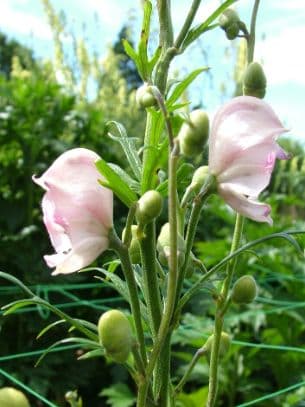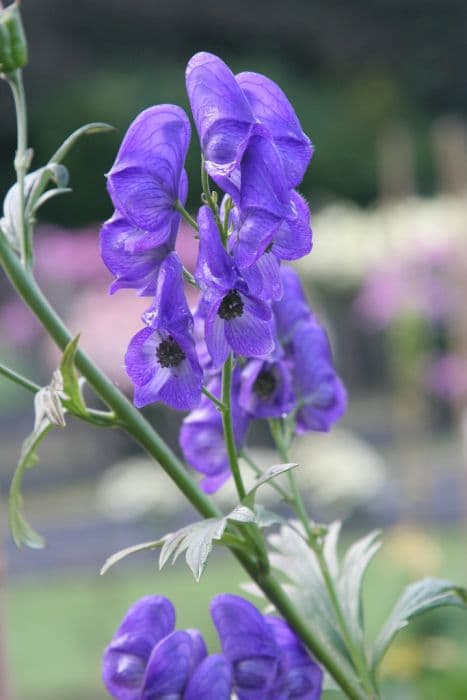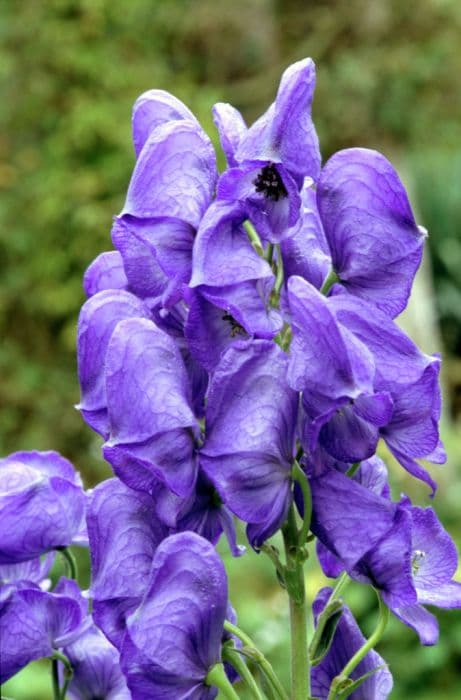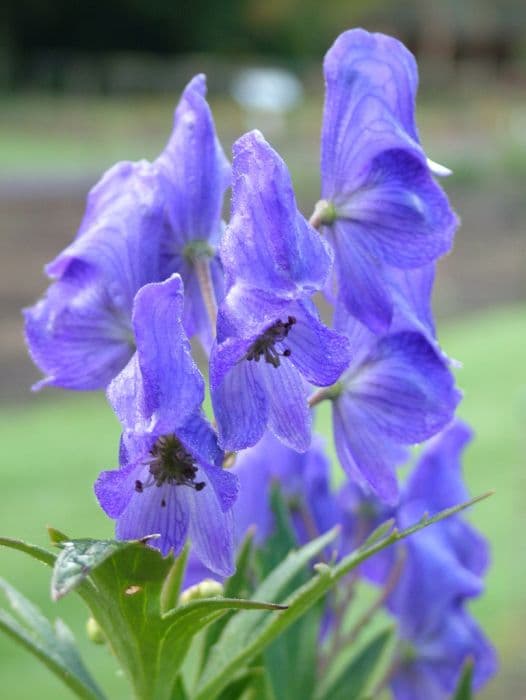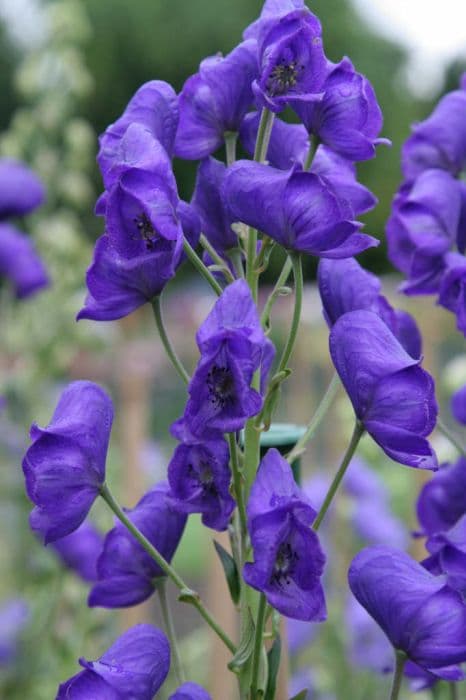Hellebore Helleborus × ericsmithii Ruby Glow = 'Blt01'

ABOUT
Helleborus × ericsmithii Ruby Glow 'Blt01', commonly known simply as hellebore, is a captivating hyrbid plant that is admired for its striking blooms and robust evergreen foliage. The hellebore's flowers boast a deep ruby glow or a sultry pinkish-red hue which can appear almost glossy under the right lighting, radiating a sense of warmth even in the chilly months when it typically flowers. The petals, which are more accurately sepals, often exhibit a lighter, cream or pale yellow hue toward the center, escalating the visual impact of the contrasting colors in a radiant display. These blossoms, cup-shaped and nodding, emerge from thick, leathery leaves that form a lush, dark green backdrop, accentuating the vibrancy of the flowers. In addition to its alluring flowers, the hellebore has a dense clump of foliage, consisting of stout stems and robust leaves. The leaves are divided into leaflets with a serrated or toothed edge, providing a rich textural quality to the plant. The overall appearance is both elegant and tough, showcasing how the plant can offer visual interest throughout the year, with its prominent floral display occurring when few other plants are in bloom.
About this plant
 Names
NamesFamily
Ranunculaceae
Synonyms
Eric Smith's Hellebore, Ruby Glow Lenten Rose
Common names
Helleborus × ericsmithii Ruby Glow = 'Blt01'.
 Toxicity
ToxicityTo humans
Hellebore, the common name for Helleborus × ericsmithii Ruby Glow, is toxic to humans. If ingested, it can cause a variety of symptoms, including abdominal pain, vomiting, and diarrhea. The plant contains compounds such as glycosides and alkaloids that can lead to symptoms upon ingestion. Contact with its sap may also cause skin irritation in some people. The toxicity of this plant emphasizes the need for caution, particularly with children and adults who might mistakenly ingest the plant. It's advised to handle hellebore with gloves to avoid direct skin contact, and one should never consume any part of it, as it could lead to poisoning.
To pets
Hellebore, the common name for Helleborus × ericsmithii Ruby Glow, is also toxic to pets. Ingestion can cause similar symptoms to those found in humans, such as drooling, abdominal pain, vomiting, and diarrhea. In severe cases, it can also cause depression, weakness, and possibly seizures. The toxic principles, including glycosides and alkaloids, affect the heart, central nervous system, and can be harmful to animals. Pet owners should prevent their pets from having access to hellebores in gardens or as cut flowers indoors to avoid the risk of poisoning. If a pet does consume any part of this plant, seek immediate veterinary assistance.
 Characteristics
CharacteristicsLife cycle
Perennials
Foliage type
Evergreen
Color of leaves
Green
Flower color
Ruby
Height
1-2 feet (30-60 cm)
Spread
1-2 feet (30-60 cm)
Plant type
Herb
Hardiness zones
5
Native area
Garden origin
Benefits
 General Benefits
General Benefits- Year-round Interest: Helleborus × ericsmithii Ruby Glow provides visual interest throughout different seasons with its evergreen foliage and winter to early spring blooming flowers.
- Drought Tolerance: Once established, it is quite tolerant of drought, making it suitable for gardeners with water restrictions or those looking to create a water-wise garden.
- Shade Loving: It thrives in partial to full shade, making it an ideal plant for underplanting beneath trees or adding color to darker areas of the garden.
- Deer and Rabbit Resistant: The plant is not palatable to deer and rabbits, protecting it from being eaten by these common garden pests.
- Low Maintenance: It has minimal maintenance requirements, needing only occasional trimming to remove old or damaged foliage.
- Attracts Pollinators: The early flowers provide valuable nectar sources for bees and other pollinators when there are few other blooms available.
- Ground Cover: Its dense growth habit makes it an effective ground cover, helping to suppress weeds and stabilize soil.
- Architectural Foliage: The leathery, dark green leaves add an architectural element to the garden even when the plant is not in bloom.
- Easy to Propagate: It can be easily propagated through division, allowing gardeners to create more plants for other areas or to share with friends.
- Long-lasting Cut Flowers: The blooms are long-lasting when cut, making them a good choice for winter and early spring floral arrangements.
- Color Variety: Ruby Glow offers deep pink to ruby-colored flowers, adding a rich and unusual hue to the garden's palette during the cooler seasons.
 Medical Properties
Medical PropertiesThis plant is not used for medical purposes.
 Air-purifying Qualities
Air-purifying QualitiesThis plant is not specifically known for air purifying qualities.
 Other Uses
Other Uses- Hellebore ink: The dark, rich colors of Hellebore flowers like Ruby Glow can be used to make a natural plant-based ink for art and dyeing purposes.
- Educational tool: Ruby Glow can be used in schools and educational programs to teach students about hybridization and plant breeding.
- Frost indicator: Owing to its winter-blooming characteristic, gardeners may employ Ruby Glow as a natural indicator of frost and temperature changes in their gardens.
- Photography subject: With its striking appearance, Ruby Glow is an excellent subject for professional and amateur photographers, particularly in the winter months when blooms are scarce.
- Theme gardens: This plant can be a highlight in a Christmas-themed garden due to its typically winter-blooming nature and association with the holiday season.
- Close landscape filling: Ruby Glow's low growth habit makes it appropriate for use in landscapes that require ground cover without obstructing views or other plantings.
- Wedding decor: The Ruby Glow Hellebore can be incorporated into winter wedding bouquets or arrangements for a unique and seasonal touch.
- Literary inspiration: Writers and poets may use Ruby Glow as a muse or motif in their work to evoke themes of perseverance through adversity, as it blooms in the harshest of winter conditions.
- Color therapy gardens: The rich ruby color of Helleborus Ruby Glow can be integrated into therapeutic gardens designed around the concept of color therapy.
- Culinary garnish: Although not edible, the petals of Ruby Glow can be placed on plates or serving trays as an aesthetically pleasing, non-toxic garnish for specialty dishes at high-end restaurants (they should not be consumed).
Interesting Facts
 Feng Shui
Feng ShuiThe Hellebore is not used in Feng Shui practice.
 Zodiac Sign Compitability
Zodiac Sign CompitabilityThe Hellebore is not used in astrology practice.
 Plant Symbolism
Plant Symbolism- Resilience: Helleborus Ruby Glow, commonly known as the "Lenten Rose," often blooms in late winter or early spring, showcasing its capability to withstand cold temperatures and harsh conditions.
- Hope: Its ability to blossom when most other plants do not, often near Lent, provides a symbol of hope and the anticipation of spring and renewal.
- Protection: Historically, Hellebores were believed to have protective qualities and were used to ward off negative influences and evil spirits, as some parts of the plant are toxic.
 Water
WaterThe Hellebore 'Ruby Glow' prefers consistent moisture, but it's crucial to avoid waterlogging. Water the plant when the top inch of soil feels dry to the touch, which might be once a week, depending on climate conditions. During the growing season, in spring and fall, this plant may require more frequent watering, particularly if it's growing in a container or during periods of dry weather. Aim to provide the Hellebore with about 1 gallon of water every time you water, ensuring you moisten the soil thoroughly without leaving standing water. In the winter, when the plant is dormant, reduce watering but do not allow the soil to completely dry out.
 Light
LightHellebore 'Ruby Glow' flourishes in partial shade, where it can receive dappled sunlight or light shade. The ideal location would be under a deciduous tree or on the north or east side of a structure, where it’s protected from the harsh afternoon sun. These light conditions will help maintain the vibrant color and health of the foliage and flowers.
 Temperature
TemperatureHellebore 'Ruby Glow' is hardy and can withstand a temperature range from 5°F to 85°F. However, it thrives best in temperatures between 50°F and 75°F. It’s important to ensure that the plant is not exposed to prolonged temperatures below its minimum threshold, or it may suffer damage.
 Pruning
PruningPruning Hellebore 'Ruby Glow' encourages healthy growth and removes unsightly or dead foliage. Prune in late winter or early spring before new growth starts. Remove old, damaged leaves to make room for new ones. Cutting back the plant after flowering also helps maintain its shape and may promote a second flush of blooms. Pruning annually will ensure your Hellebore looks its best.
 Cleaning
CleaningAs needed
 Soil
SoilHellebore 'Ruby Glow' thrives in well-drained, fertile soil with good organic content, favoring a neutral to alkaline pH between 7.0 and 8.0. The best soil mix can be achieved by combining loamy garden soil with compost and perlite to ensure ample drainage and nutrient availability.
 Repotting
RepottingHellebore 'Ruby Glow' generally does not require frequent repotting and can be repotted every 2-3 years. Ensure that the new pot has adequate drainage holes and is one size larger than the previous pot to allow room for growth.
 Humidity & Misting
Humidity & MistingHellebore 'Ruby Glow' is tolerant of a range of humidity levels but prefers moderate humidity. It thrives outdoors where it can receive natural humidity, but if grown indoors, it does not typically require additional humidity control measures.
 Suitable locations
Suitable locationsIndoor
Place in bright indirect light, avoid hot, dry conditions.
Outdoor
Plant in dappled shade, shelter from extreme weather.
Hardiness zone
5-9 USDA
 Life cycle
Life cycleHellebore 'Ruby Glow' begins its life cycle as a seed that germinates in the spring, usually in temperate climates. After germination, the seedling grows into a small plant with a rosette of leaves at the ground level. As the plant matures, it develops a deep root system and evergreen foliage, becoming more resistant to cold and drought. Typically, in late winter to early spring, 'Ruby Glow' produces clusters of burgundy to pink flowers which last for several weeks. Once pollinated, the flowers develop into capsules containing numerous seeds that are eventually dispersed, completing the reproductive cycle. The plant then enters a period of dormancy during the hottest parts of the year, conserving energy for the next flowering season.
 Propogation
PropogationPropogation time
Late Winter to Early Spring
The Helleborus x ericsmithii Ruby Glow, also known as the Lenten Rose 'Ruby Glow', is typically propagated through division, which is a popular method due to its simplicity and effectiveness. This should be done in late winter or early spring before the plant begins its active growth. To propagate by division, carefully lift the plant and gently separate it into smaller clumps, ensuring that each new section has at least two or three growth buds. These divisions can then be replanted immediately into well-prepared soil, ideally enriched with organic matter, at the same depth they were growing before. Water the new plants thoroughly and continue to provide regular moisture as they establish themselves.

